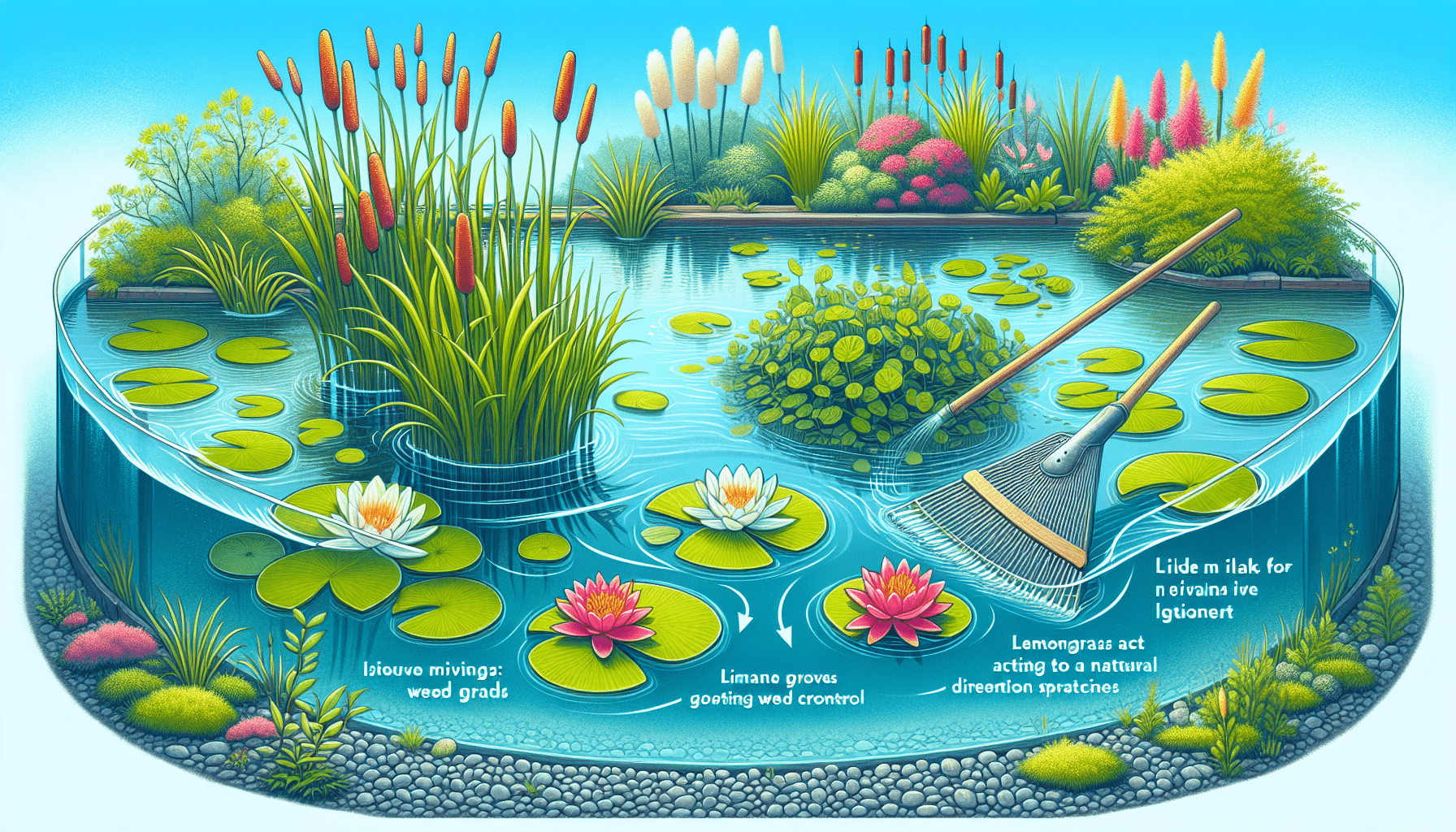In your serene water garden, the last thing you want is the unwelcome appearance of alligator weed disrupting the peaceful ambiance. With its rapid growth and tenacious nature, this invasive plant can quickly overshadow the beauty of your aquatic haven. But don’t worry! This article will guide you through the most effective methods to prevent alligator weed from taking root and flourishing in your water garden, ensuring that your slice of paradise remains picture-perfect and enjoyable for years to come. Have you ever found yourself battling relentless alligator weed in your beautiful water garden? If so, you’re not alone. Many garden enthusiasts face the same challenge. Alligator weed (Alternanthera philoxeroides) can be a persistent and stubborn aquatic invader that poses significant difficulties. But fear not! By understanding its behavior and implementing effective strategies, you can reclaim your water garden from this invasive species. Let’s dive into some practical and effective ways to prevent alligator weed growth in water gardens.
Understanding Alligator Weed
Alligator weed is an invasive aquatic plant known for its rapid growth and propensity to smother other vegetation. It thrives in warm, moist environments and can easily choke out native plants, disturb wildlife habitats, and impede water flow.
Characteristics of Alligator Weed
Identification
Alligator weed has distinctive opposite leaves, which are shiny, lance-shaped, and can grow up to 10 cm long. The flowers are small, white, and bloom in dense clusters. The stems are hollow, aiding its ability to float or grow in waterlogged areas.
Growth Habit
Alligator weed is highly adaptive and can flourish in both aquatic and terrestrial environments. It propagates quickly through fragmentation, where broken pieces of the plant can root and grow into new plants.
Why Is It a Problem?
Efforts to control alligator weed are complicated because it can outcompete native plants for sunlight, nutrients, and space. It also disrupts aquatic ecosystems by altering the habitat and reducing biodiversity. Lastly, it can impact recreational water activities and agriculture by clogging waterways.
Preventive Measures
Preventing the growth of alligator weed is more effective than trying to eliminate it after it has established itself. Here are several preventive measures to consider:
Site Selection
Choose the right location for your water garden, preferably away from natural water sources that can harbor invasive plants. This will reduce the likelihood of alligator weed spreading into your garden.
Proper Plant Selection
Opt for native or non-invasive plant species that are well-adapted to your region’s climate and conditions. This can help create a balanced ecosystem that is less susceptible to invasions.
Barriers
Installing physical barriers can help prevent alligator weed from entering or spreading in your garden.
| Barrier Type | Description |
|---|---|
| Floating Barriers | Positioned around the perimeter to prevent fragments from floating in. |
| Subsurface Barriers | Installed at the bottom to prevent roots from spreading. |
| Terrestrial Barriers | Surrounding the garden to stop land-based spread. |
Regular Monitoring
Consistently monitor your water garden for early signs of alligator weed. Regular inspection allows you to address infestations before they become severe.

Mechanical Control Methods
Mechanical methods involve physically removing alligator weed from your garden. These methods are most effective when combined with other control strategies.
Manual Removal
Hand-pulling the weed is labor-intensive but effective for small infestations. Ensure you remove all fragments to prevent regrowth.
Mowing and Cutting
Using aquatic mowers or cutters can help manage larger infestations. It’s crucial to collect and dispose of all cut plant material to avoid accidental spread.
Dredging
Dredging removes alligator weed along with its roots and stems, making it a more comprehensive, albeit expensive, method. This is often used in severe cases.
Biological Control Methods
Biological control involves using natural enemies to reduce the alligator weed population.
Insect Herbivores
The introduction of herbivorous insects, such as the alligator weed flea beetle (Agasicles hygrophila) and the alligator weed thrips (Amynothrips andersoni), can help manage the weed. These insects feed on alligator weed, weakening and reducing its growth.
Plant Pathogens
Certain fungi and bacteria can infect and kill alligator weed. While effective, this method requires careful management to avoid affecting native plants.

Chemical Control Methods
Chemical methods involve the application of herbicides to control alligator weed. This approach should be used as a last resort due to potential environmental impacts.
Selective Herbicides
Herbicides like glyphosate and imazapyr can effectively control alligator weed. Always follow the manufacturer’s instructions and consider the impact on non-target species.
Application Techniques
| Technique | Description |
|---|---|
| Spraying | Applying herbicides directly onto the leaves of the weed. |
| Wicking/Wiping | Using a herbicide-soaked cloth to wipe the weeds, minimizing exposure to other plants. |
| Injection | Directly injecting herbicide into the plant stems for a targeted approach. |
Integrated Weed Management
Integrated Weed Management (IWM) combines multiple control methods for a more effective and sustainable approach.
Combining Methods
Utilize a combination of mechanical, biological, and chemical controls to address different aspects of alligator weed growth. For example, after mechanical removal, introduce insect herbivores and use selective herbicides on any remaining weeds.
Long-Term Monitoring
IWM requires ongoing monitoring to adjust methods as necessary and ensure long-term success. Regularly reassess the effectiveness of each control method and make adjustments to improve outcomes.
Community Involvement
Engage with your local community, including gardeners, environmental groups, and authorities, to share knowledge and resources. Collaborative efforts can significantly enhance the effectiveness of alligator weed management.
Maintaining a Healthy Water Garden Ecosystem
Creating a balanced and well-maintained ecosystem can naturally resist the invasion of alligator weed and other pests.
Plant Diversity
Introduce a variety of plants to your water garden. Diversity can create a more resilient ecosystem that is less prone to invasions.
Beneficial Wildlife
Encourage the presence of beneficial wildlife, such as fish and insects, that can help control weed growth. Frogs, for instance, can feed on pests that may otherwise harm your plants.
Water Quality Management
Maintain high water quality by regularly testing and adjusting parameters like pH, oxygen levels, and nutrient content. Healthy water conditions deter the growth of invasive species.
Soil and Mulch
Use appropriate soil and mulch to prevent weeds from taking root. Mulching can also help retain moisture and improve soil health.
Case Study: Successful Alligator Weed Management
Let’s look at a real-world example of successful alligator weed management to illustrate these principles.
The Challenge
A community pond was overrun with alligator weed, impacting local wildlife and the aesthetic value of the area. Initial efforts to control the weed using herbicides alone were unsuccessful.
The Solution
The community implemented an IWM approach:
- Mechanical removal of alligator weed was conducted using floating barriers and dredging.
- Herbivorous insects were introduced to manage regrowth.
- Selective herbicides were applied to remaining patches.
- Native plant species were planted to restore balance.
The Outcome
Within a year, the alligator weed infestation was significantly reduced, and the pond’s ecosystem began to recover. Continued monitoring and community involvement have kept the problem in check, showcasing the effectiveness of an integrated approach.
Conclusion
Controlling alligator weed growth in water gardens is challenging but achievable with a combination of preventive measures, mechanical and biological controls, and careful use of herbicides. By understanding the characteristics of alligator weed and implementing integrated weed management strategies, you can protect your water garden from this invasive species. Regular monitoring, community involvement, and maintaining a healthy ecosystem are key to long-term success. So, roll up your sleeves and use these effective methods to reclaim your water garden!
